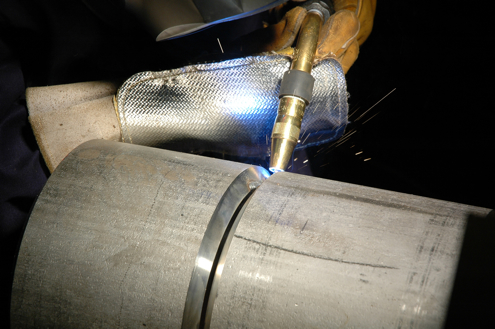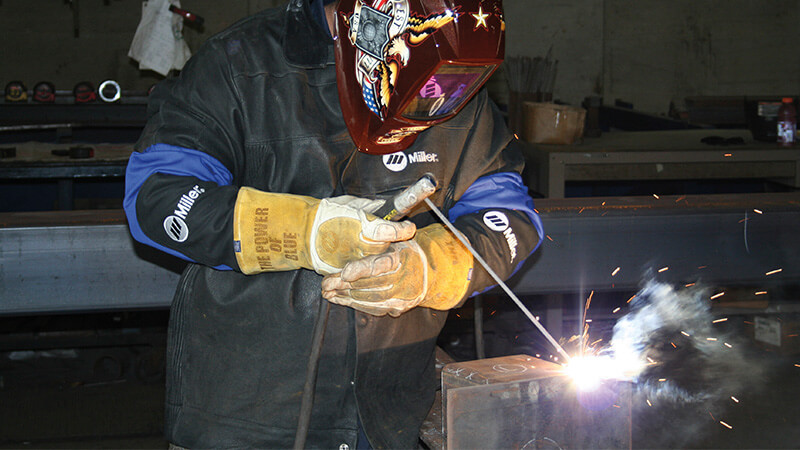How to respond when encountering porosity in Montana Mobile Welding and Repair Welding
Common Welding Repair Service Issues and Just How to Address Them Effectively
Welding repairs frequently run into a series of problems that can threaten the integrity of the last product. Common troubles consist of poor infiltration, porosity, and imbalance, among others. Each defect offers special challenges that need details approaches for resolution. Understanding these problems is important for welders aiming to boost their end results and abilities. This discussion will certainly check out these common welding fixing problems and reliable methods to address them.
Inadequate Infiltration
Inadequate penetration happens when the weld steel fails to totally fuse with the base product, resulting in weak joints and potential architectural failures. This problem commonly stems from not enough heat input, inaccurate electrode angle, or improper welding speed. Welders might come across inadequate penetration because of a mistake of the needed parameters for a certain product thickness or kind. Furthermore, contamination on the base material's surface can hinder reliable bonding, worsening the problem. To attend to poor infiltration, welders should assure suitable setups on their equipment and maintain a clean work surface area. Routine examination of welds is suggested to identify any kind of shortages early, allowing for timely improvements and the avoidance of jeopardized architectural honesty in bonded assemblies.
Porosity
Porosity is a typical flaw in welded joints that shows up as little gas bubbles caught within the weld metal. This flaw can jeopardize the integrity of the weld, causing minimized toughness and prospective failing under stress and anxiety. Montana Mobile Welding and Repair Belgrade. Porosity generally occurs from contamination, dampness, or inappropriate welding techniques, which allow gases to leave right into the liquified weld swimming pool. To deal with porosity, welders ought to guarantee proper surface prep work, keep a clean working setting, and utilize suitable welding criteria. Furthermore, selecting the right filler product and protecting gas can mitigate gas entrapment. Regular evaluation and screening of welds can help identify porosity early, ensuring prompt corrective actions are taken, therefore protecting the top quality and integrity of the welded framework
Imbalance
Misalignment in welding can emerge from numerous elements, consisting of inappropriate arrangement and thermal development. Understanding the origin is vital for efficient resolution. Numerous adjustment techniques are offered to straighten components and ensure architectural integrity.
Reasons of Misalignment
Welding imbalance commonly comes from a selection of underlying issues that can endanger architectural integrity. One key cause is inappropriate fit-up of components prior to welding, which can bring about gaps and unequal surface areas. Variations in thermal development throughout the welding process can additionally lead to distortion, specifically if the products being signed up with have different coefficients of development. Additionally, insufficient fixturing and securing may stop working to hold parts safely in position, causing activity throughout welding. Badly kept tools, consisting of welding makers and devices, might present inconsistencies in the weld grain, more contributing to misalignment. Lastly, operator error, coming from inadequate training or experience, can also play a significant function in developing misaligned welds.
Correction Methods Available
Dealing with misalignment successfully needs a combination of corrective strategies customized to the details concerns available. One common method is using jigs or components to hold components in the proper position during welding, ensuring consistent placement. Furthermore, pre-heating the materials can help minimize distortion and enhance fit-up. For substantial misalignment, mechanical realignment strategies, such as using hydraulic jacks or clamps, can be used to deal with the setting prior to welding. Post-weld heat therapy might also be essential to relieve tensions created by imbalance. Ultimately, cautious examination and change throughout the setup phase can protect against imbalance issues from ending up being substantial troubles, advertising a smoother welding process and enhancing general architectural stability.
Distortion
Distortion is a typical obstacle in welding that can emerge from various elements, consisting of unequal heating & cooling. Comprehending the reasons of distortion is important for applying efficient avoidance strategies. Addressing this concern not only improves architectural stability but likewise boosts the total quality of the weld.
Reasons for Distortion
When based on the intense warmth of welding, materials typically undergo adjustments that can result in distortion. This sensation largely emerges from thermal growth and contraction throughout the welding process. As the weld location heats up, the product expands; upon air conditioning, it acquires, which can create inner tensions. Furthermore, unequal heating throughout a work surface can exacerbate these tensions, resulting in warping or bending. The type of product likewise plays a significant role; metals with varying thermal conductivity and coefficients of growth might react differently, causing uncertain distortions. Moreover, poor joint style and inadequate fixturing can add to misalignment official website throughout welding, increasing the chance of distortion. Understanding these reasons is important for reliable welding repair and prevention approaches.
Avoidance Techniques
Efficient avoidance methods for distortion during welding concentrate on controlling warm input and making sure proper joint design. Keeping a constant warmth input helps to lessen thermal growth and contraction, which can lead to distortion. Making use of strategies such as pre-heating the workpiece can also decrease the temperature level slope, promoting consistent heating. Additionally, picking proper joint designs, such as T-joints or lap joints, can boost security and decrease stress concentrations. Executing correct fixturing to protect the work surfaces in area better aids in keeping positioning throughout the welding process. Staggered welding sequences can distribute warmth a lot more equally, preventing local distortion. By using these strategies, welders can significantly lower the probability of distortion and enhance the Click Here overall quality of their welds.
Fracturing
Breaking is an usual problem experienced in welding repair services, typically resulting from various aspects such as incorrect cooling prices, material selection, or inadequate joint preparation. The event of cracks can significantly jeopardize the integrity of the weld, resulting in potential failures throughout operation. To address this concern, welders have to initially assess the origin triggers, guaranteeing that materials are compatible and suitably chosen for the certain application. In addition, managing the cooling rate during the welding procedure is crucial; quick air conditioning can induce stress and anxiety and cause breaking. Proper joint style and prep work also add to minimizing the threat. Implementing these strategies can improve weld high quality and resilience, inevitably decreasing the likelihood of breaking in completed weldments.

Insufficient Combination
A significant problem in welding repair work is insufficient blend, which occurs when the weld steel does not appropriately bond with the base product or previous weld passes - Montana Mobile Welding and Repair. This flaw can result in weaknesses in the joint, potentially compromising the stability of the welded structure. Elements adding to incomplete fusion include not enough warm input, incorrect welding strategy, and contamination of the surface areas being signed up with. To address this concern successfully, welders must guarantee Going Here proper pre-weld cleaning and surface preparation, in addition to adjust their welding specifications to achieve sufficient penetration and fusion. Routine inspection throughout the welding procedure can additionally help determine incomplete blend early, allowing for timely restorative steps to boost the total high quality of the weld
Overheating
While welding fixings can improve structural integrity, overheating presents a substantial obstacle that can bring about product degradation. Excessive warmth during welding can alter the mechanical buildings of steels, leading to reduced stamina, raised brittleness, and warping. This phenomenon is especially essential in high-stress applications where architectural reliability is paramount. Recognizing getting too hot can involve visual assessments for staining or distortion, as well as checking temperature level during the welding process. To reduce the threats connected with getting too hot, welders ought to employ ideal methods, such as regulating warmth input, readjusting travel speed, and using suitable filler materials. Additionally, carrying out pre- and post-weld heat therapies can aid recover material residential properties and boost the general top quality of the repair service, making sure long-lasting efficiency and safety.
Often Asked Inquiries
What Are the Common Signs of a Welding Issue?

Just How Can I Test My Welds for High quality?
To check welds for high quality, one can use visual evaluations, ultrasonic screening, and radiographic approaches. Each strategy ensures structural honesty, identifies defects, and validates adherence to defined requirements, inevitably improving the reliability of the bonded joints.
What Safety Precautions Should I Take While Welding?
When welding, one must focus on safety and security by putting on proper individual safety devices, guaranteeing appropriate ventilation, securing flammable materials away, maintaining a tidy office, and recognizing environments to stop injuries and crashes.
Can I Fix a Weld Without Redesigning the Entire Joint?
Fixing a weld without remodeling the entire joint is possible, depending upon the damages (Belgrade Fabrication). Techniques such as grinding, including filler product, or utilizing a welding process can efficiently attend to particular flaws while maintaining the surrounding framework
What Equipment Are Important for Reliable Welding Repair Works?
Necessary tools for efficient welding repairs consist of a welding machine, cable brush, mill, safety gear, clamps, and filler products. Each device plays an important function in ensuring high quality and security throughout the fixing procedure. Porosity usually emerges from contamination, wetness, or inappropriate welding strategies, which enable gases to leave into the liquified weld swimming pool. Badly conserved equipment, consisting of welding machines and devices, might introduce inconsistencies in the weld grain, more adding to misalignment. When subjected to the intense heat of welding, materials frequently undertake adjustments that can lead to distortion. Breaking is a typical problem encountered in welding repairs, typically resulting from numerous factors such as inappropriate air conditioning prices, material option, or inadequate joint prep work. A significant problem in welding repairs is insufficient fusion, which happens when the weld metal does not appropriately bond with the base material or previous weld passes.